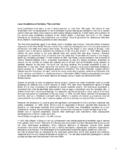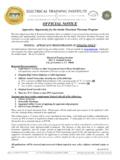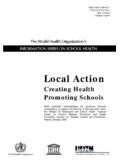Transcription of Local Production of Pharmaceuticals - WHO
1 HNP DISCUSSION PAPERA bout this series is produced by the Health, Nutrition, and Population Family(HNP) of the World Bank s Human Development Network. The papersin this series aim to provide a vehicle for publishing preliminary andunpolished results on HNP topics to encourage discussion and findings, interpretations, and conclusions expressed in this paperare entirely those of the author(s) and should not be attributed in anymanner to the World Bank, to its affiliated organizations or to membersof its Board of Executive Directors or the countries they and the use of material presented in this series should takeinto account this provisional character. For free copies of papers inthis series please contact the individual authors whose name appearson the about the series and submissions should be made directly tothe Managing Editor Joy de Beyer or HNPA dvisory Service tel 202 473-2256, fax202 522-3234).
2 For more information, see also WORLD BANK1818 H Street, NWWashington, DC USA 20433 Telephone:202 473 1000 Facsimile:202 477 6391 Internet: Production of Pharmaceuticals :Industrial Policy and Access to MedicinesAn Overview of Key Concepts, Issues and Opportunitiesfor Future ResearchWarren Kaplan and Richard LaingJanuary 2005 Local Production OF Pharmaceuticals : INDUSTRIAL POLICY AND ACCESS TO MEDICINES An Overview of Key Concepts, Issues and Opportunities for Future Research Warren Kaplan and Richard Laing January 2005ii Health, Nutrition and Population (HNP) Discussion Paper This series is produced by the Health, Nutrition, and Population Family (HNP) of the World Bank's Human Development Network (HNP Discussion Paper). The papers in this series aim to provide a vehicle for publishing preliminary and unpolished results on HNP topics to encourage discussion and debate.
3 The findings, interpretations, and conclusions expressed in this paper are entirely those of the author(s) and should not be attributed in any manner to the World Bank, to its affiliated organizations or to members of its Board of Executive Directors or the countries they represent. Citation and the use of material presented in this series should take into account this provisional character. For free copies of papers in this series please contact the individual authors whose name appears on the paper. Enquiries about the series and submissions should be made directly to the Managing Editor. Submissions should have been previously reviewed and cleared by the sponsoring department that will bear the cost of publication. No additional reviews will be undertaken after submission. The sponsoring department and authors bear full responsibility for the quality of the technical contents and presentation of material in the series.
4 Since the material will be published as presented, authors should submit an electronic copy in the predefined format. Rough drafts that do not meet minimum presentational standards may be returned to authors for more work before being accepted. The Managing Editor of the series is Joy de Beyer The Editor in Chief of the series is Alexander S. Preker For information regarding this and other World Bank publications, please contact the HNP Advisory Services at: Tel (202) 473-2256; and Fax (202) 522-3234. 2005 The International Bank for Reconstruction and Development / The World Bank 1818 H Street, NW Washington, DC 20433 All rights reserved. iii Health, Nutrition and Population (HNP) Discussion Paper Local Production : INDUSTRIAL POLICY AND ACCESS TO MEDICINES An Overview of Key Concepts, Issues, and Opportunities for Future Research Warren A.
5 Kaplana and Richard Laingb a Assistant Professor of International Health, Center for International Health & Development, Department of International Health, Boston University School of Public Health, Boston, MA, b Medical Officer, Essential Drugs and Medicines, World Health Organization, Geneva, Switzerland Paper prepared for World Bank Meeting on the Role of Generics and Local Industry in Attaining the Millennium Development Goals (MDGs) in Pharmaceuticals and Vaccines Conference Washington, , June 24, 2003 Abstract: Local Production of Pharmaceuticals in developing countries may be seen as helping to stimulate industrial policy and/or as stimulating pharmaceutical access to needed medicines. However, if a developing country with manufacturing facilities is able to finish off bulk active ingredients sourced from developed or other countries at high costs, such manufacture may have no impact whatever on patient access to needed medicines.
6 There has been some critical thinking in the past regarding whether or not small developing countries should make their own Pharmaceuticals , but no recent comprehensive summary of the issues and policy options. This paper summarizes the issues surrounding Local Production from a policy and public health viewpoint. It provides four brief country-level case studies, and reviews the evidence supporting the industrial policy assumptions underlying the goal of Local Production . In brief, in many parts of the world, producing medicines domestically makes little economic sense. If many countries begin Local Production , the result may be less access to medicines, since economies of scale may be lost if there are Production facilities in many countries. The document concludes by providing a research agenda specifically designed to test assumptions about Local Production of Pharmaceuticals .
7 Keywords: pharmaceutical , Local Production , health policy, industrial policy Disclaimer: The findings, interpretations and conclusions expressed in the paper are entirely those of the authors, and do not represent the views of the World Bank, its Executive Directors, or the countries they represent. This paper was written when both authors were affiliated with the Boston University School of Public Health. Correspondence Details: Warren Kaplan, , JD, MPH; Center for International Health & Development, Boston University School of Public Health, 85. East Concord St., Boston, MA 02118 Tel: (617) 414-1152; Email: iv v Table of Contents VII ACKNOWLEDGEMENTS .. IX 1 THE TENSION BETWEEN INDUSTRIAL POLICY AND HEALTH 1 Local Production of Pharmaceuticals : One Aspect of this Tension.
8 1 This Tension is Exacerbated by Global Trade Rules .. 2 Objectives of the Discussion Paper .. 2 FRAMING THE ISSUES: (1) CONCEPTS AND DEFINITIONS .. 3 DECONSTRUCTING Local Production .. 3 What Do We Mean by Production ? .. 3 What Do We Mean by Local ? .. 6 Local Production IN THE CONTEXT OF THE GLOBAL pharmaceutical 7 DYNAMIC AND FRAGMENTED INFORMATION AT THE REGIONAL/ Local 8 FRAMING THE ISSUES (2) .. 8 INDUSTRIAL AND HEALTH POLICY ASSUMPTIONS ABOUT Local 8 Local Production Will Save Foreign Exchange .. 9 Local Production Creates Jobs .. 9 Local Production Facilitates Technology Transfer .. 9 Local Production Will Stimulate Exports to Neighboring Countries .. 9 Raw Materials Are Readily Available and Are Cheaper Than Finished Products .. 9 Achieving Self-sufficiency in Drug Supply.
9 10 Recent Efforts at Revisiting the Local Production Assumptions .. 11 IS Local Production FEASIBLE FOR SMALL DEVELOPING COUNTRIES? IF SO, WHICH ONES?.. 12 CASE STUDIES AND ECONOMIC AND TRADE 12 Case 12 Economic/Trade Data .. 18 25 DISCUSSION: POLICY OPTIONS .. 26 POLICY OPTIONS: 26 Let the Rich Middle-Income Countries Supply Pharmaceuticals .. 26 Support a True Indigenous Production with Various Types of Technology Transfer .. 27 Create a Level Playing Field by Enabling Trade, Regulatory and IP Rules to Allow Access to Assured Quality, Effective Medicines for Everyone and Let the Market Determine the Best Local Producers.. 28 POLICY OPTIONS: THINK GLOBALLY, ACT 28 SETTING A RESEARCH AGENDA .. 31 TESTING THE Local Production ASSUMPTIONS AGAINST THE 31 vi Generating Good Data on Local Production .
10 31 Testing the Long-term Effect of TRIPS on the pharmaceutical Industry and on pharmaceutical Access, Quality and Use .. 31 Testing the Assumptions About Local 31 Creating a Predictive Index of Local Production Based on Easily Measurable 33 CONCLUSIONS .. 33 BIBLIOGRAPHY .. 37 List of Figures Figure 1:Schematic block diagram of a pharmaceutical manufacturing Figure 2: pharmaceutical Balance of Trade: Supplying the Domestic Figure 3: Total Governmental Expenditure on Healthcare and Local Figure 4: Value of Local Production and Industrial Figure 5: Local Production (Y) and pharmaceutical Trade Balance (X)..23 Figure 6: Local Production and Secondary School Figure 7: Local Production and Tertiary School vii FOREWORD Several inputs are indispensable in ensuring that health services function properly.















